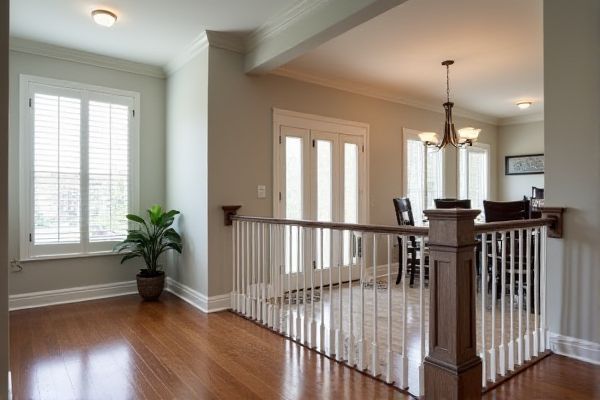
Modern railing designs emphasize sleek lines, minimalism, and materials like glass, stainless steel, or cable, creating an open and contemporary aesthetic. Explore the rest of the article to discover how your choice between modern and traditional railing can transform the look and feel of your space.
Table of Comparison
| Feature | Modern Railing | Traditional Railing |
|---|---|---|
| Material | Stainless steel, glass, aluminum | Wood, wrought iron |
| Design | Sleek, minimalist, contemporary | Ornate, classic, decorative |
| Durability | High resistance to rust and weather | Prone to rot and corrosion over time |
| Maintenance | Low maintenance; easy cleaning | Requires regular painting and repair |
| Installation | Modular and quicker installation | Labor-intensive and time-consuming |
| Cost | Moderate to high, depends on materials | Varies; generally lower initial cost |
| Safety | Meets modern building codes; sturdy | May require upgrades for compliance |
| Customization | Limited but precise options | Highly customizable with intricate details |
Introduction to Modern and Traditional Railings
Modern railings emphasize sleek lines, minimalistic design, and innovative materials such as stainless steel, glass, and aluminum, offering durability and a contemporary aesthetic. Traditional railings are characterized by ornate details, classic wood or wrought iron craftsmanship, and timeless appeal that complements historical or vintage architecture. The choice between modern and traditional railings impacts both the visual style and functional aspects of staircases, balconies, or decks.
Design Aesthetics: Modern vs Traditional
Modern railing designs emphasize sleek lines, minimalistic forms, and often incorporate materials like glass, stainless steel, or cable for a contemporary look that enhances open spaces and natural light. Traditional railings feature ornate details, curved shapes, and classic materials such as wrought iron or wood, providing a timeless, elegant appeal that complements historic or vintage architecture. Your choice between modern and traditional railing significantly impacts the visual harmony and style consistency of your property's interior or exterior design.
Material Comparison: Steel, Glass, and Wood
Modern railings often use steel and glass, providing sleek durability and enhanced visibility, while traditional railings primarily feature wood, offering classic warmth and natural appeal. Steel railings deliver exceptional strength and low maintenance, glass panels contribute to an open, airy aesthetic, and wood systems require regular upkeep but bring timeless charm. Choosing between these materials depends on your preference for style, maintenance level, and structural needs in your railing project.
Safety Features in Modern and Traditional Railings
Modern railing systems incorporate advanced safety features such as tempered glass panels, anti-slip materials, and reinforced metal frames, enhancing both durability and accident prevention. Traditional railings often rely on wood or wrought iron, which may lack these modern enhancements but can still provide substantial protection through sturdy craftsmanship and proper maintenance. Your choice between modern and traditional railings should consider the specific safety standards required for your space, as modern options typically meet updated building codes more effectively.
Installation Process: Ease and Complexity
Modern railing installation often involves prefabricated components and modular designs that simplify the process, reducing labor time and minimizing on-site adjustments. Traditional railing installation typically requires custom measurements, cutting, and welding or joinery, which demand skilled labor and increase complexity. The streamlined installation of modern railings results in faster project completion and lower overall costs compared to the intricate and time-consuming procedures of traditional railings.
Durability and Maintenance Requirements
Modern railings, often constructed from materials like stainless steel, aluminum, or tempered glass, offer superior durability and require minimal maintenance due to resistance against rust, corrosion, and weathering. Traditional railings, typically made from wood or wrought iron, demand frequent upkeep such as painting, sealing, or rust treatment to prevent deterioration and maintain structural integrity. The longevity and low maintenance of modern railings make them a cost-effective and practical choice for contemporary architectural designs.
Cost Analysis: Initial Investment and Long-Term Value
Modern railing systems often demand a higher initial investment due to advanced materials like stainless steel or tempered glass, but their durability and low maintenance offer superior long-term value. Traditional railings, such as wood or wrought iron, typically have lower upfront costs but may require frequent repairs or replacements that increase lifetime expenses. Evaluating Your budget against longevity needs helps determine whether the upfront cost of modern railing delivers better overall financial efficiency compared to traditional options.
Customization Options and Flexibility
Modern railing systems offer extensive customization options, including a variety of materials like stainless steel, glass, and aluminum, allowing for sleek, contemporary designs tailored to specific architectural styles. Traditional railing focuses on classic materials such as wrought iron and wood, often limited to standard styles with less flexibility in design alterations. The adaptability of modern railings provides enhanced flexibility to meet unique spatial requirements and aesthetic preferences, surpassing the fixed patterns commonly found in traditional railings.
Popular Applications and Use Cases
Modern railing systems are widely used in commercial spaces, contemporary homes, and outdoor decks due to their sleek design and durable materials like glass, stainless steel, and aluminum, offering unobstructed views and minimal maintenance. Traditional railings, often made from wrought iron or wood, remain popular in historic restorations, classic-style homes, and gardens, providing decorative appeal and a timeless aesthetic. Both railing types are essential for safety and code compliance in staircases, balconies, and terraces, with modern options favored for urban and minimalist designs while traditional railings suit vintage and rustic environments.
Which Railing Style Suits Your Space?
Modern railing features sleek lines, minimalistic designs, and materials like glass or stainless steel that enhance open, contemporary spaces with a clean, airy feel. Traditional railing showcases ornate details, wood craftsmanship, and classic profiles that complement cozy, classic interiors or historical architecture. Choosing the right railing style depends on your space's overall aesthetic, balancing modern simplicity or traditional warmth to create visual harmony.
 homyna.com
homyna.com